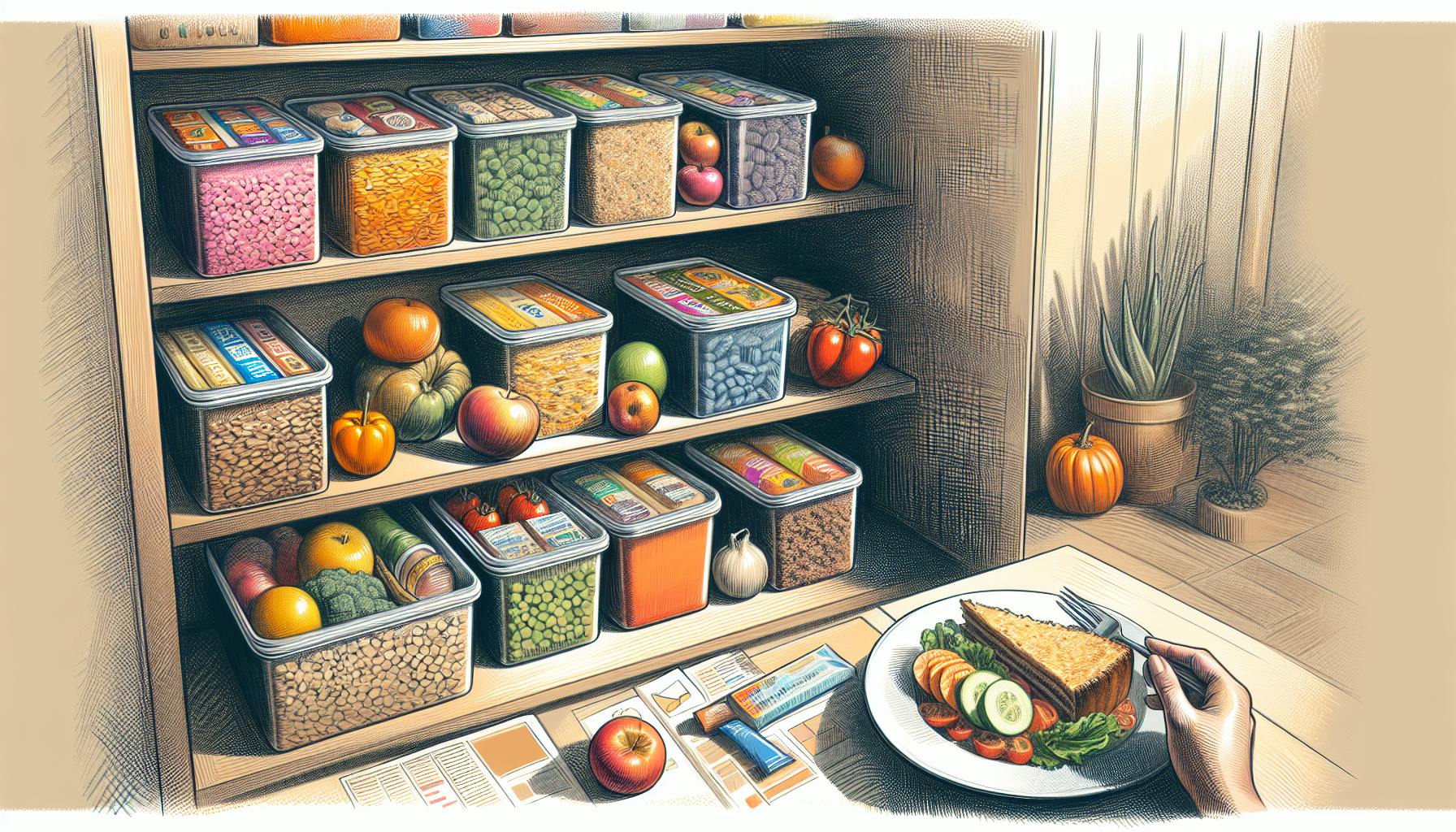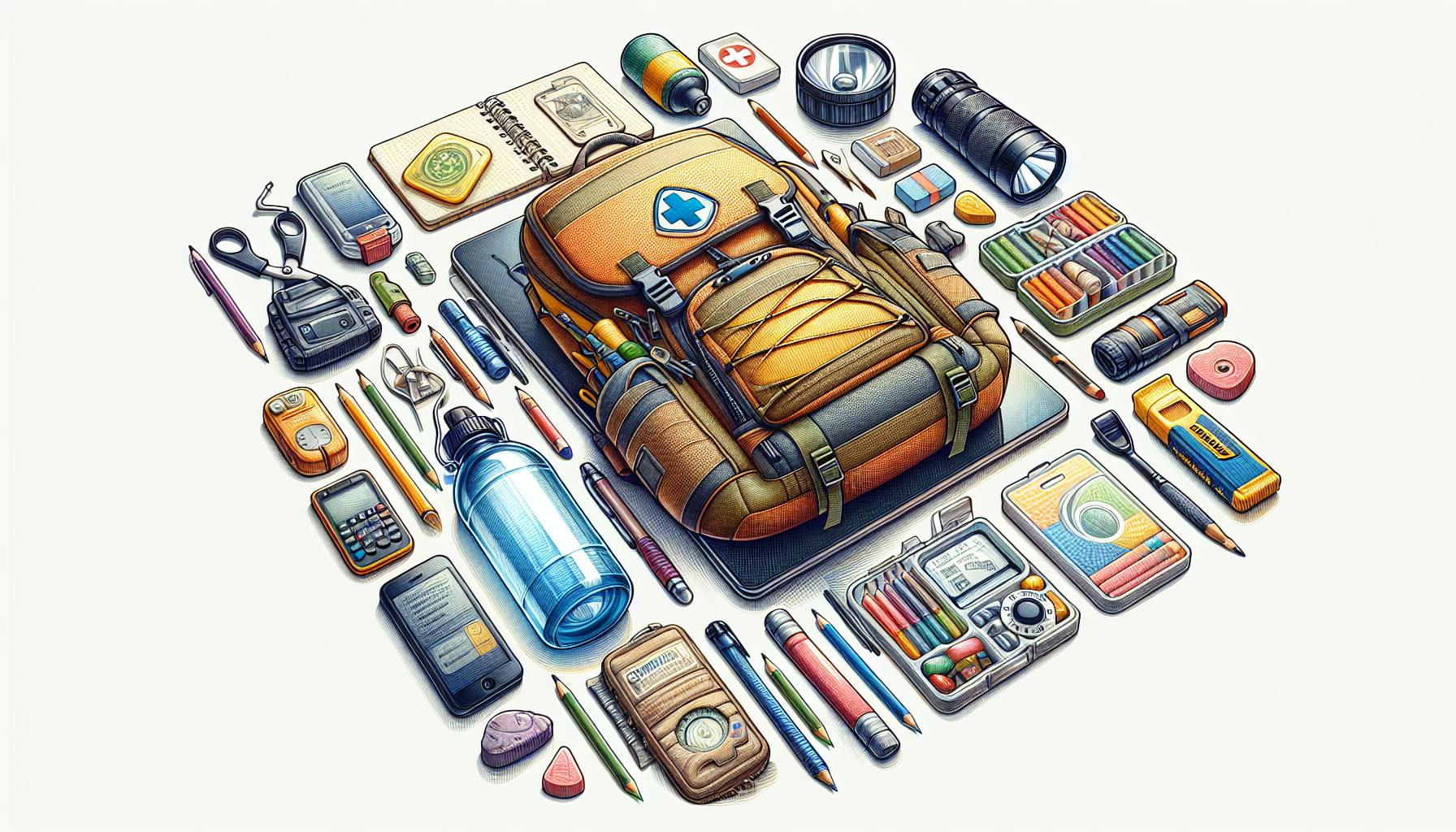When it comes to emergency preparedness, most people would agree that having a stockpile of canned goods is an essential part of being ready for disasters or other emergencies.
By learning some key canned food prepping strategies tailored for beginners, you can start putting together an emergency food supply that will keep your family fed in times of crisis.
In this post, you'll discover budget-friendly ways to build up a canned food stockpile, how to choose nutritious and safe canned goods with a long shelf life, the best storage methods to maximize freshness, and some handy recipes to try out using your canned food supply.
Introduction to Canned Food Prepping for Beginners
Canned food prepping involves stockpiling shelf-stable canned goods as part of an emergency preparedness plan. Having a supply of canned foods that can last for years without refrigeration is a cornerstone of survival preparedness.
Understanding Canned Food Prepping for Survival
Canned food prepping allows you to build up a robust emergency pantry, ensuring you have food security if a disaster strikes. Non-perishable canned goods are designed to last for years, providing nourishment if stores close or supply chains are disrupted. A survival canned food list should include nutrient-dense options like canned vegetables, fruits, beans, tuna, and soups.
The Role of Canned Goods in an Emergency Preparedness Kit
In an emergency preparedness kit, canned goods serve as reliable nutrition sources with long shelf lives. Foods like canned beans, meat, fish, and fruit can sustain you when access to fresh foods is limited. Rotate your stockpile to use older cans first and check expiration dates. Include a can opener and eating utensils.
Advantages of Canned Foods That Last a Long Time
Properly stored canned goods can remain edible for decades, making them ideal for emergency pantries. The canning process kills bacteria and seals out new contaminants. Canned options like vegetables, broths, and whole grains provide stable nutrition. Choose low-sodium varieties whenever possible for health.
Are canned foods good for prepping?
Canned foods can be a very useful part of an emergency food supply. Here are some of the benefits of stockpiling canned goods:
-
Convenience - Canned foods are ready to eat after opening. You don't need to worry about cooking or preparing meals if you lose power.
-
Inexpensive - Buying canned food in bulk when it's on sale is an affordable way to build up reserves. Opt for store brands to save even more.
-
Long shelf life - Most canned goods last at least 1-2 years when properly stored, some much longer. Just be sure to check expiration dates.
-
Compact storage - Canned goods stack efficiently on shelves, freeing up space. Opt for #10 cans for even more compact storage.
-
Variety - There's a diverse range of canned meats, fruits, vegetables, soups and more to choose from.
When stocking your emergency canned food supply, prioritize nutritious, high-calorie options like beans, tuna fish, salmon, vegetables, and fruits packed in juice rather than syrup. Also be sure to rotate and replace items before they expire.
Overall, having 2-4 weeks' worth of canned goods can provide sustenance if stores close or supply chains are disrupted. Canned foods definitely deserve a place in any prepper's emergency stockpile.
How long does canned food last survival?
Canned foods can last a surprisingly long time when properly stored. For high acid foods like fruits and tomatoes, you can expect a shelf life of 12-18 months before quality starts to decline. Low acid foods like meats and vegetables keep even longer - generally 2 to 5 years.
Here are some tips for maximizing canned food shelf life:
- Check for dents, rust, or swelling before stocking cans. Avoid any with flaws.
- Store cans in a cool, dark place between 50°F and 70°F. Temperature fluctuations shorten shelf life.
- Keep canned food dry to prevent rust and contamination.
- Organize your stock by expiration date and use the oldest cans first.
- Most canned food remains safe to eat long past its best by date, as long as cans are in good condition. Smell and inspect contents before consuming.
- Consider rotating out cans after 5 years, even if still good. Quality slowly declines over time.
With proper storage, most canned goods can safely last for years beyond their printed date. Just be diligent about checking cans for damage and contamination before opening. A good rotation system will ensure you can enjoy high quality emergency food when you need it most.
What is the longest lasting food for prepping?
When building an emergency food supply, it's important to focus on shelf-stable foods that have a long shelf life. Some of the best options include:
Peanut Butter
An excellent source of protein and healthy fats, commercially-processed peanut butter can last up to 3 years unopened. Once opened, it will last about 3-4 months in the pantry. Consider stocking some peanut butter powder as well which lasts even longer.
Whole-Wheat Crackers
Look for crackers made without hydrogenated oils or trans fats as these can cause them to spoil more quickly. Properly stored whole-wheat crackers can last 6-12 months past their printed date. Pair with peanut butter for added nutrition.
Nuts and Trail Mixes
Buy raw nuts in bulk and roast your own. Properly stored in airtight containers, most nuts will keep for up to a year in the pantry. Trail mixes with dried fruit and dark chocolate make tasty high-calorie snacks.
Canned Tuna, Salmon, Chicken
Canned fish and meat can last 2-5 years unopened. Opt for water-packed varieties with minimal salt and preservatives. Store in cool, dark place and check for dents, rust, or swelling before opening.
The key is storing foods properly and checking expiration dates routinely to ensure safety and freshness. With some planning, you can build up a substantial long-term food supply.
What are four rules for storing canned food?
When storing canned foods for emergency preparedness, follow these four key rules:
-
Store in a cool, clean, dry place. The ideal storage temperature is between 50-70°F. Temperatures above 85°F can shorten shelf life. Make sure the storage area is free of dirt, pests, and moisture.
-
Rotate stock. Use a "first-in, first-out" system, where older cans are placed in front and used before newer additions. This ensures nothing expires before getting used.
-
Don't keep cans longer than 1 year. While some cans may last 2-5 years, limiting to 1 year helps ensure safety and quality. Exceptions can be made for certain products like vegetable oils.
-
Use canned meats and seafood within 3 years. The USDA recommends using canned meats and seafood within this timeframe for safety and quality assurance.
Following these basic rules will help you safely build an emergency food supply with canned goods. Check expiration dates, look for damage, and integrate rotation. With some planning, canned foods can be an integral part of your preparedness efforts.
sbb-itb-b932644
Planning Your Canned Food Prepping Strategy
Canned food can serve as the foundation of an emergency food supply. When planning your canned food prepping strategy, the first steps involve budgeting funds to build your supply and determining what products make sense for your situation.
Budgeting for Bulk Canned Food
When starting out, take inventory of any canned goods you already have on hand. This will help determine how much additional food you need to purchase. Prioritize buying versatile ingredients like beans, tomatoes, vegetables, fruits, meats, broths, and soups, which can be used in many recipes.
To save money, look for bulk deals and sales on canned goods at big box stores like Costco. Buying # of cans at once brings down the per-unit price. Store brands also tend to cost less than name brands without sacrificing quality.
Aim to set aside $100-200 initially for canned goods. Building your supply over time is more affordable than buying everything at once. Re-evaluate your budget every few months and add funds as possible.
Choosing the Right Canned Products for Your Emergency Fund
Focus on shelf-stable foods with a long expiration date. Canned meats, fish, beans, vegetables, and fruits tend to last 2-5 years when stored properly.
Prioritize nutritious options like beans, salmon, tuna, vegetables, and low-sodium soups. Items packed in water rather than syrup or oil are healthier. Low-acid foods like meat and veggies have a longer shelf life than fruit.
Stick to reputable brands that thoroughly pressure-cook their products to prevent botulism. Carefully inspect cans for dents, rust, or swelling before purchasing.
Creating an Emergency Pantry List
An well-rounded emergency pantry includes a variety of canned goods:
- Protein: Canned tuna, salmon, chicken, turkey, ham, beef, beans, chili
- Fruits and veggies: Canned tomatoes, pumpkin, peas, carrots, pineapple, pears, peaches
- Baking/Cooking: Canned milk, coconut milk, broth, soups
- Comfort foods: Canned pasta, mac and cheese, ravioli
Tailor your list based on your household's needs and preferences. Having 50-100 cans provides adequate variety for short-term emergencies.
Developing an Emergency Plan with Canned Food Prepping Ideas
Get started on emergency planning using these canned food tips:
- Take a canned food inventory
- Research recipes to make with your supply
- Calculate daily calorie needs for your household
- Determine water and fuel needs for cooking
- Explore manual can openers in case of power loss
- Create an emergency contacts list
Integrating canned goods into your plan establishes a basic layer of food security. Continually build on your supply and preparedness knowledge over time.
Selecting the Best Canned Food for Survival
When building your emergency food supply, it's important to choose canned goods that will provide balanced nutrition to support health during a crisis. Here are some tips:
Survival Canned Food List: Essentials for Nutritional Balance
Focus on canned foods that offer protein, fruits/vegetables, and whole grains. Good options include:
- Canned tuna, salmon, chicken for protein
- Canned beans, lentils for plant-based protein
- Canned fruits packed in juice or water
- Canned vegetables low in sodium
- Canned 100% whole wheat crackers or pasta
Choose low-sugar canned fruits and look for vegetables with no added salt or preservatives.
Low-Sodium Options in Canned Goods
Selecting low-sodium canned goods is ideal for long-term storage. High-sodium foods can negatively impact blood pressure and cardiovascular health over time. Seek out "no salt added" or "low sodium" on the label.
Prioritize nutrients over taste - in an emergency, supporting health is most vital. However, some low-sodium options still offer decent flavor.
57 Foods to Stockpile: Canned Edition
An expanded canned foods list could include:
- Canned tuna, salmon, chicken, turkey, ham
- Canned beans, chickpeas, lentils
- Canned fruits like peaches, pears, pineapple, applesauce
- Canned vegetables like peas, carrots, spinach, beets
- Canned tomato sauce, pasta sauce, diced tomatoes
- Canned soups like vegetable, minestrone, chicken noodle
- Canned 100% whole grains like brown rice, quinoa, oats
- Canned nuts like almonds and walnuts
- Canned stews, chili with meat/beans
Check expiration dates, buy in bulk on sale when possible, and rotate stock. Storing a diverse supply ensures balanced nutrition.
Storing and Organizing Your Canned Food Supply
Properly storing canned goods in a cool, dry place preserves quality and extends shelf life. Here are some best practices for organizing your canned food supply.
Optimizing Storage Conditions for Canned Goods
- Store cans in a basement or interior room with stable, moderate temperature and low humidity. Temperature should remain between 50°F and 70°F.
- Avoid storing cans in attics, garages or near appliances that emit heat or moisture.
- Shelving, pallets or storage containers should be used to keep canned goods off concrete floors and protect from flooding.
- Canned goods should not be exposed to direct sunlight which can affect taste and nutrition over time. Use opaque storage bins or cover shelving.
Storing Canned Food: A Systematic Approach
Organize using an inventory system to track what you have and when it expires:
- Categorize by type - fruits, vegetables, meats. Alphabetize cans within each category.
- Label shelves with category names and use dividers to separate types of canned goods.
- Create a master list of all canned goods, quantities and purchase/expiration dates. Update after each new purchase.
- Use oldest stock first by rotating new inventory to the back and pulling from front.
Check Expiration Dates: Ensuring Food Safety
- Inspect each can before use and check the expiration or “best by" date printed on the lid.
- Generally, high-acid canned goods like fruits and tomatoes can be safely consumed up to 12-18 months past date. Low-acid foods like meats only 6-12 months past date.
- Discard any swollen, leaking or heavily dented cans even if not expired. These may contain bacteria.
- Wipe the lid of each can clean before opening to prevent contamination. Use a manual can opener and wash hands afterwards.
Following organized storage methods and monitoring expiration dates ensures the quality and safety of your emergency canned food supply over time.
Maintaining and Updating Your Canned Food Prepping Inventory
Routine Inspection of Canned Goods
It is important to periodically inspect your canned goods for any signs of damage or spoilage. Here are some tips:
- Check cans for dents, rust, bulging lids, or leakage. Damaged cans may allow bacteria to enter and spoil the contents. Safely dispose of any compromised cans.
- Wipe down undamaged cans to remove dust and debris. This allows you to easily see any new dents or rust over time.
- Organize cans with earliest expiration dates in front. This rotation system ensures that older cans get used first.
- Set reminders to inspect cans every 2-3 months. Frequently checking cans means catching any issues early.
Replenishing Your Emergency Pantry List
Rotate canned goods before they expire by following this routine:
- Take inventory of soon-to-expire cans every 6 months.
- Create a shopping list to replace them with fresh cans. Refer back to your emergency pantry list for key items.
- Shop bulk sales and specials when restocking. This keeps costs low.
- Date and organize new cans behind existing inventory per the rotation system.
Aim to replenish about 20% of your supply every 6 months. This ensures you have a stable stockpile of non-expired emergency food.
Incorporating New Canned Food Prepping Recipes
Adding variety keeps your emergency meal plan interesting. Try these recipe ideas:
- Mix canned chicken, beans, onions, and seasonings for quick tacos.
- Blend canned fruit into smoothies for a cool, nutritious breakfast.
- Simmer canned vegetables with bouillon and pasta for a warming soup.
- Bake canned pie fillings into single-serving fruit crisps for dessert.
Search online or prepper books for more canned food recipes. Varying meals, cooking methods, and flavors prevents taste fatigue if relying on your stockpile during an emergency.
Rotating new recipes every 2-3 months keeps your plan engaging and ensures you use different canned goods in your pantry before each expiration date.
Cooking with Your Canned Food Supply
Getting the most value from your canned food supply involves regularly using and cooking with the stored goods before their expiration date. This allows you to cycle through your emergency provisions, keeping them fresh while also saving money on grocery bills.
Canned Food Prepping Recipes for Daily Meals
Canned ingredients like beans, tomatoes, tuna, vegetables, and fruits can form the base of easy, nutritious meals. Try recipes like:
-
White bean and tuna salad - Mix canned tuna, white beans, olive oil, lemon juice, garlic, and herbs for a protein-packed lunch.
-
Veggie chili - Sauté onion and garlic, then simmer with canned beans, corn, tomatoes, and chili powder for a hearty stew.
-
Canned peach cobbler - Dump canned peaches into a baking dish, top with biscuit dough and bake for a simple, tasty dessert.
Get creative with combining canned meat, veggies, beans, and fruit into easy casseroles, salads, pastas, and more!
Creative Canned Food Prepping Ideas for Meal Planning
To avoid taste fatigue from repetitive canned food dishes, try ideas like:
-
Global flavors - Create Mexican, Italian, Asian dishes using canned beans, tomatoes, corn, etc.
-
Mix and match - Make pasta primavera, minestrone soup, salmon cakes by combining various canned goods.
-
Spice it up - Jazz up canned tuna and salmon with Cajun seasoning, curry powder, harissa paste, etc.
-
Bake, don't boil - Turn canned fruit into crisps, cakes, compotes. Or make bean burgers versus plain boiled beans.
Getting creative with seasonings and cooking methods keeps canned food exciting.
Non-Perishable Food for Emergency: Recipe Adaptations
During emergencies, adapt favorite recipes to use non-perishable ingredients on hand:
-
Substitute canned milk for fresh dairy in baked goods, creamy soups, oatmeal, etc.
-
Use canned chicken/tuna in casseroles, pasta dishes, sandwiches that typically call for fresh meat.
-
Swap frozen veggies for canned in stir fries, frittatas, rice bowls and more.
With some simple tweaking, you can make comforting, familiar dishes with non-perishables in an emergency.
Conclusion: The Essentials of Canned Food Prepping
Recap of Canned Food Prepping Strategies
When building an emergency canned food supply, focus on nutrient-dense, non-perishable items with a long shelf life. Prioritize proteins, fruits, vegetables, beans, soups, and meals ready-to-eat. Calculate about 300-500 calories per person per day. Store what you eat and eat what you store to cycle through products. Organize by category and use first in, first out. Inspect cans regularly and replace expired or damaged items.
Final Thoughts on Survival Food Prepping
Preparing for emergencies starts with small steps. Build up a supply of canned goods over time within your budget. Make an inventory list and emergency plan for accessing your food. Getting organized ahead of time brings peace of mind. While unexpected events are out of our control, we can control our level of readiness. A well-stocked pantry provides comfort knowing you can feed your family in a crisis.


